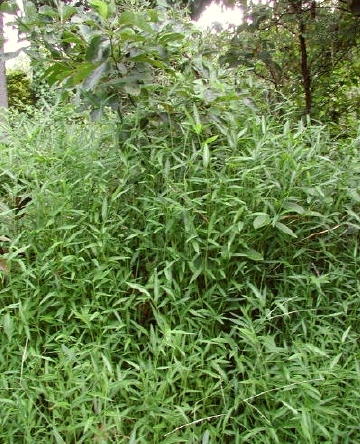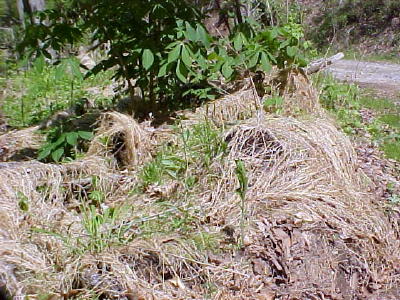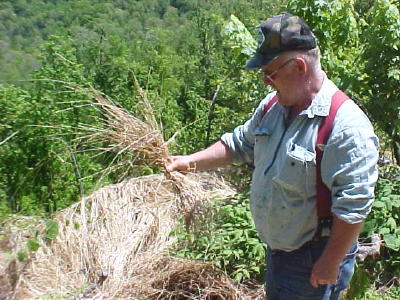
Japanese Stilt Grass in the growing stage
EDITOR'S NOTE: In the past few months we have been reporting on what may be a major threat to our woodlands, the trees, shrubs, herbs and plants that grow there - Japanese Stilt Grass, with the Little Kanawha Basin being the most infested area. - BW
Traveling around Calhoun, I have spotted it most everywhere.
Forester Russ Richardson has been leading the educational effort about the grass, which suffocates most everything in its path, including new trees.
If you don't know what it looks like - alive or dead - check pictures on the Hur Herald.
Richardson has been conducting seminars on Crummies Creek with foresters, biologists, scientists and educators to begin looking at the problem and the solution. Richardson comments on the status of the rapidly spreading grass. - Bob Weaver
NOW IS THE TIME TO WEED WHACK
By Russ Richardson
We are now at the only time during the growing season where cutting or weed whacking Japanese Stilt Grass (Microstegium vimineum) will prevent seeds from being set. The toxic and invasive annual grass is nearing maturity and will soon start to produce extremely small blue flowers with the mature seed ready to drop just a few days after the flowers appear. Each mature plant can produce up to 1000 seeds.
Japanese Stilt Grass has shown up this summer in nearly every road, woodlot and stream bank in Calhoun County and is being noticed in every region of West Virginia from the Eastern Panhandle to Monongahela National Forest, to the coal fields of McDowell County. Presently, invasion of the terrain within the Little Kanawha River basin is out of control and we are rapidly becoming one of the most heavily infested areas of West Virginia.
Foresters, biologists, conservationists and sportsmen are becoming extremely concerned about the rapid spread of the plant and research to study the long term impact of stilt grass on our local hardwood forests will not likely begin in earnest until at least 2005.

Stilt Grass in the dry stage

Russ Richardson
This fall a study of the impact of Japanese Stilt Grass on the health and diversity of forest understory plants is being initiated by Ohio University in Athens. Additional research efforts are being proposed by Penn State and NC State University. Although West Virginia's hardwood forests appear to be more susceptible to damage from the arrival of stilt grass than many areas where it has already taken up residence and become established, there are still no active stilt grass studies underway in the Mountain State.
If you are still unsure what Japanese Stilt Grass looks like, in addition to roadsides and stream banks, you can find it in heavily grazed bottom land pastures where there are 3 foot tall patches of grass that the cows and horses will not eat. Stilt Grass can be found around horse paddocks, barn yards, ATV trails, game trails, gas and oil well service roads and well locations, old log landings and nearly any place a bulldozer has passed in the past couple of years. Stilt Grass is heavily concentrated in areas impacted by the 2003 ice storm and is likely to be present any place where ice storm salvage logging has occurred.
The only certain way to slow the spread is to prevent seed from setting. The seed that is already in the ground from last year will continue to sprout for at least three more growing seasons. Stilt Grass will die with our first frost and become extremely flammable once it dries out.
If your stilt grass has been mowed or weed whacked prior to mid August you will have a difficult time preventing seed production by mowing and use of herbicides may be your only available option. Early summer mowing encourages stilt grass plants to produce seed at a much shorter height. For best results, cut stilt grass down by Labor Day to prevent seeding.
| 


